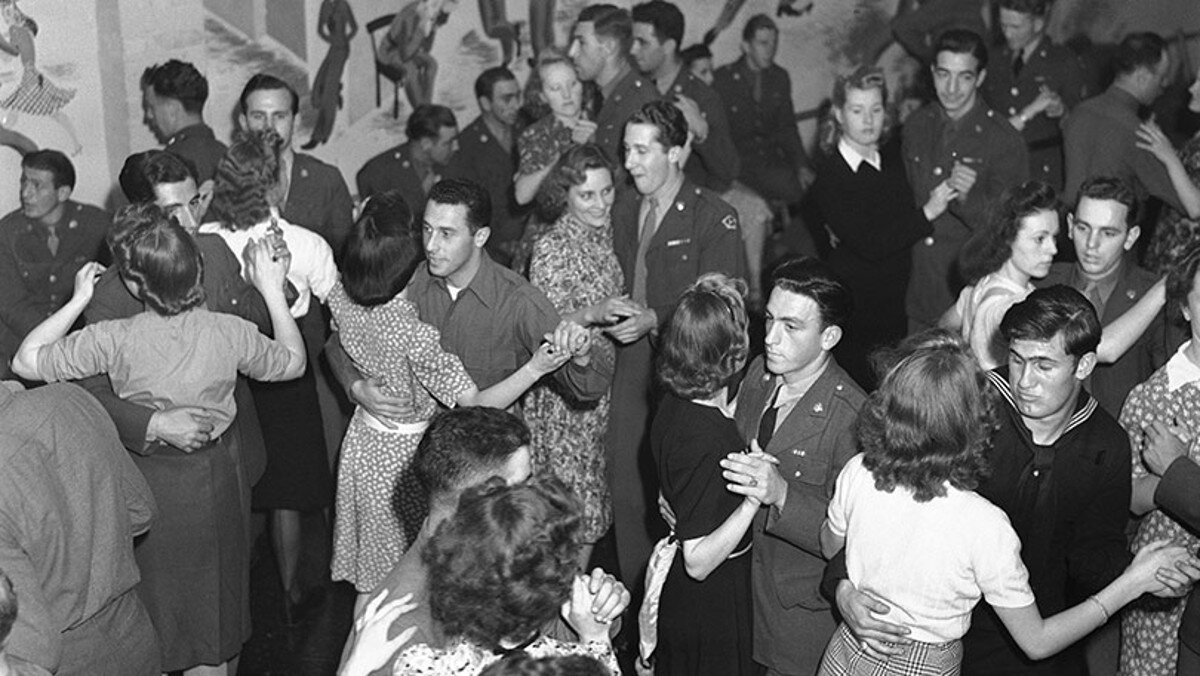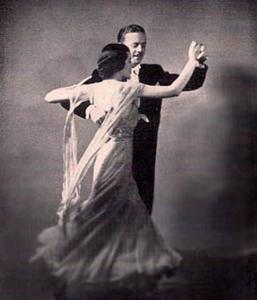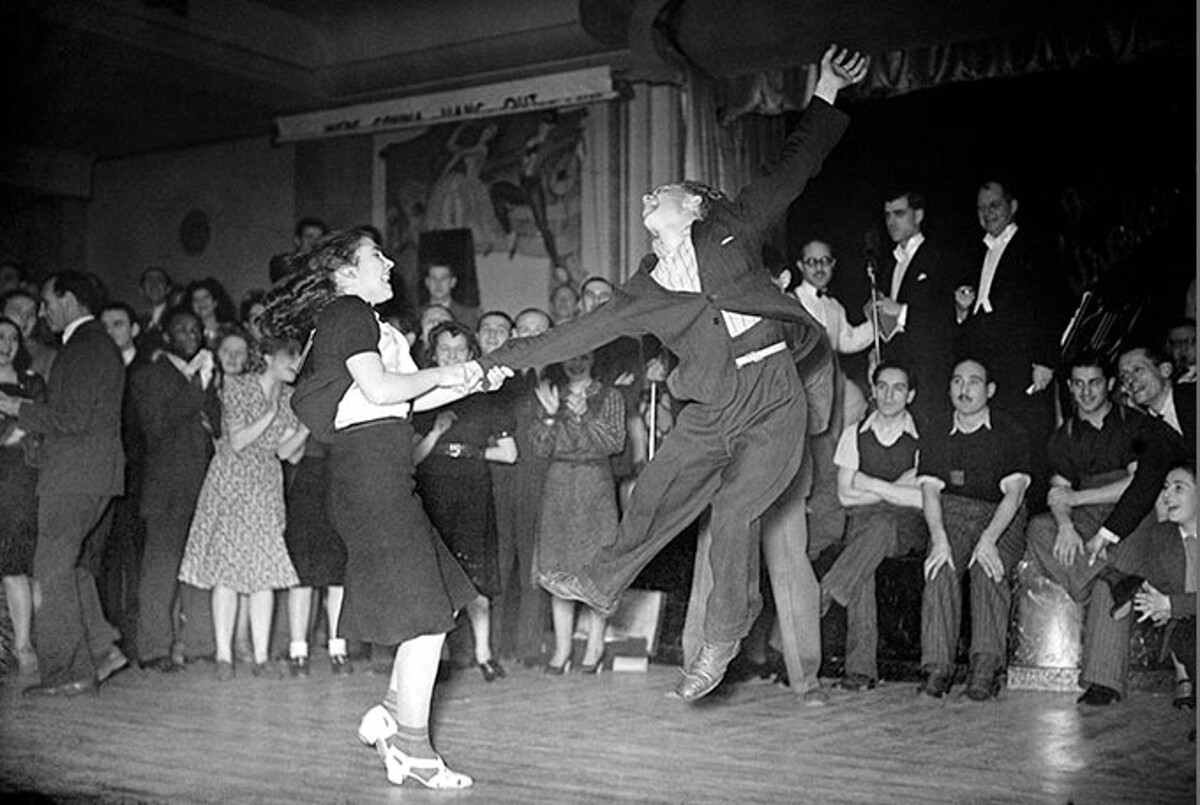There is a persistent myth, especially among younger swing dancers, that 1942 marked a watershed in Britain’s toe-tapping habits. That was the year the US GIs came, bringing not only nylons but the bombastic bombshell we Brits called jitterbug; blasting old-fashioned styles (whatever they were) clean off the floor and into the dustbin of dance history. But the truth is more nuanced and curious, as recorded by historian James Nott in his 2015 tome Going to the Palais.
Nott’s fascinating, footloose foray into old-time couples dancing in Britain charts its rise from an ad hoc pub pastime—via Victorian village halls and public park bandstands—to big business, serving liquor and live music to millions of eager shoe-shufflers each week. Around 11,000 dancehalls and nightclubs opened around Britain between 1919 and 1926, fueled by a rise in working class wages and the advent of paid holidays. The biggest of these borrowed from French in christening themselves palais (de danse), echoing the glamour of private ballrooms at up-market hotels like the Savoy. Soon, palais had caught on among working class Brits as the name for a dedicated dancehall.
British dance during the early twentieth century was defined by fads, Nott reported. It had long been a group activity, comprised of set sequences to familiar tunes (see any screen adaptation of a Jane Austen novel for examples). The musical comedy The Sunshine Girl introduced dancers to the tango in 1912, marking the beginning of a shift from sequence to social dancing. Hand-wringing snobs in the upper class dance establishment hoped this lowly “dancing mania” would pass—but the arrival of jazz on English shores soon put those hopes to bed.

New styles designed for two were imported alongside the exotic, novel notes sounding across the Atlantic. Their uptake was accelerated by an embryonic youth culture, with teenagers returning from war and making the palais their hangout; gamely adopting the cakewalk, turkey trot, bunny hug, and Charleston through the 1910s and 1920s. The last of these was particularly popular, after being exhibited in London by New York troupe the Midnight Follies during 1925; the Royal Albert Hall’s 1926 Charleston Ball drew 10,000 attendees, with competitions judged by none other than Fred Astaire.
The next two decades saw a commercialization of social dance, with record companies competing to release the catchiest dance tracks and grooviest steps. Some—like the chestnut tree, Lambeth walk, and palais glide—were home-grown neo-traditions, countering the uncouth “negro rhythms… not suited to English temperament,” as one contemporary commentator put it. (A 2007 article by literature professor Rishona Zimring sheds further light on the race politics of social dance in Britain.)
When Lindy hop first caught British eyes—not in 1942 but in 1938, when Picture Post popped its proverbial monocle over “dance madness in the USA”—it got a similarly cold shoulder from the dance snobs. When jitterbug first landed on UK floors the following year, Dancing Times decried its “vulgar” movements, “compared to which the wildest Charlestons and black bottoms of a few years back seem as sober and stately as minuets.”
Music hall star Gracie Fields brought the style to even wider attention when she performed a pastiche to “I’ve Got the Jitterbugs” in 1939 musical movie Shipyard Sally. But, like most prior American imports (with one notable exception, on which more later), it caught on for only a short time—even among open-minded youngsters—and in a limited number of places, Nott’s book records. By 1941 it was old hat, although the influx of American troops did see it enjoy a second wind in 1942. Still, while the Lindy hop did take Newcastle and Blackpool briefly by storm, Liverpool and Manchester dancers were not having a bar of it.

Jitterbugging was also kept in check by its prohibition at many venues, especially those located in swimming baths. Popular hangouts in mid-century Britain, the public pools often had retractable dance floors which rolled into place over the water. Proprietors regularly put up “No Jitterbugging” signs, for fear that excessive bopping might see patrons crash through the boards and into the deep end. (Zimring, citing the famous British Mass-Observation project of the 1930s to 1950s, says these bans had racial motivations also.) Were it not for a worldwide revival in the 1980s, Lindy hop might have burned out altogether by war’s end.
So what were most Brits dancing during wartime, if not swing? Another cultural import, birthed by the blues, actually remained the British social dance of choice from 1914 all the way through to the 1960s. First demonstrated over here at London’s fashionable 400 Club, the foxtrot appealed to soldiers on leave from both World Wars, with its close hold and simple steps. By 1915 it was well-established, with foxtrot contests offering up to £1,500 in prizes. As music evolved, so too did the foxtrot; the arrival of jazz (and US troops in 1917) prompted dancers to pick up the pace and create the quickstep; a relatively stoic, perhaps very British response to a momentous shift in music.
Still, as younger, lower-class dancers moved with the times, rich snobs sought to preserve old traditions (when not inventing them). The result was the so-called English Style, born of Dancing Times conferences held during the 1920s. Just as the English language combined Latin and Germanic inputs, so the English Style (or ballroom, to most of us) took the tango, foxtrot, and other imports and froze them in time, adorning them with sequins and fixed grins.
Some UK dance teachers even tried to “civilise” jitterbug, creating the watered-down, very British swing style we call jive (American counterparts did the same, naming the result West Coast swing). In fact, ask the average Brit what folks danced during the 1940s and most will erroneously reply “jive,” so successful was this cultural appropriation. This transatlantic hybrid actually took off post-1945, and also became incorporated into the English Style under the Latin category. (No, I don’t understand, either.)
Thankfully, Britain can now boast an enormous traditional Lindy hop community, dancing old-time American swing the way it should be danced. And although modern British dancers rightly venerate the style’s African-American roots, perhaps we Brits should still call it jitterbug, as a nod to the curiously complex route it took to get us here.
Dave Doyle is a swing dancer, dance teacher, and journalist based in Gloucestershire, England. Write him at davedoylecomms@gmail.com. Find him on Twitter @DaveDoyleComms.






















